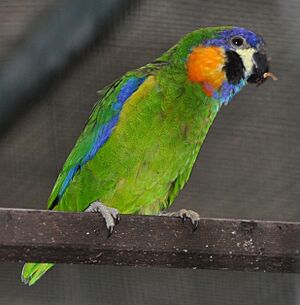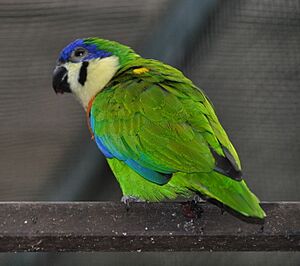Blue-fronted fig parrot facts for kids
Quick facts for kids Blue-fronted fig parrot |
|
|---|---|
 |
|
| Female | |
 |
|
| Male | |
| Conservation status | |
| Scientific classification | |
| Genus: |
Cyclopsitta
|
| Species: |
gulielmitertii
|
The blue-fronted fig parrot (Cyclopsitta gulielmitertii) is a small, colorful parrot. It lives in the warm, wet lowland forests of New Guinea. You can also find it on Salawati island and the Bird's Head Peninsula.
Contents
About Its Name
This parrot is part of a group of parrots called Cyclopsitta. The name Cyclopsitta comes from two words. Cyclops refers to the mythical one-eyed giants. Psitta is a Latin word meaning parrot.
The second part of its scientific name, gulielmitertii, honors William III. He was the King of the Netherlands. This is why the parrot is sometimes called William's fig parrot or King of Holland fig parrot.
What It Looks Like
The blue-fronted fig parrot is mostly green. It has a black beak and a white face with a black spot.
- Male parrots have bright orange chests.
- Female parrots have orange patches on their faces.
Where It Lives
This parrot makes its home in the lowland forests of New Guinea. It also lives on the Bird's Head Peninsula and Salawati island.
You usually find these parrots at low elevations. This means from sea level up to about 300 meters (about 984 feet) high. Sometimes, they can be found higher, up to 1,100 meters (about 3,600 feet).
How It Behaves
Blue-fronted fig parrots often fly around in small groups. These groups usually have about 6 to 10 birds. They mostly stay high up in the treetops. This is the very top layer of the forest. But sometimes, they will fly down to lower branches.
What It Eats
These parrots mainly eat the seeds from fig trees. They also enjoy seeds from Glochidion and Acacia auriculaeformis plants. Sometimes, they eat the flower heads of Poikilospermum plants too.
How It Breeds
Blue-fronted fig parrots lay their eggs between December and June. They usually make their nests in holes. These holes are often found in termite mounds that are built on trees. They might also nest in epiphytes, which are plants that grow on other plants.
When kept in zoos, female parrots usually lay two eggs. They can lay between one and three eggs. The eggs hatch after about 20 to 22 days. The young birds stay in the nest for about 35 to 42 days before they are ready to fly.
Its Conservation Status
The blue-fronted fig parrot is listed as a least-concern species. This means that the IUCN believes it is not currently at risk of disappearing.


